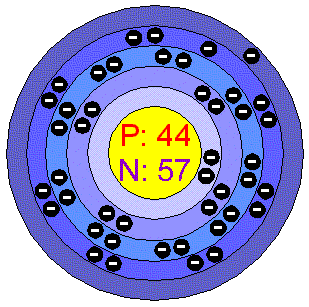|

|
|

|
RutheniumRuthenium, together with Rhodium, Palladium, Osmium, Iridium, and Platinum form a group of elements referred to as the Platinum group metals (PGM). Ruthenium is a hard, white metal. It does not tarnish at room temperatures, but oxidises in air at about 800°C. The metal is not attacked by hot or cold acids or aqua regia, but when Potassium chlorate is added to the solution, it oxidises explosively. It dissolved in molten alkalis. Applications Ruthenium demand is rising: the metal find use in the electronic industry (50%) and the chemical industry (40%), with smaller amounts being used in alloying. In electronics it used to be used mainly for electrical contacts but most now goes into chip resistors. In the chemical industry it is used in the anodes for Chlorine production in electrochemical cells. The metal is used as a hardener for Palladium
and Platinum and added in small amounts improves
the corrosion resistance of Titaniumin. It is
used in electrical contact alloys and filaments, in jewelry, in pen
nibs, and in instrument pivots. It is also used in alloys with
Cobalt, Molybdenum,
Nickel, Tungsten, and
other metals. Ruthenium compounds are used to color ceramics and glass.
Ruthenium in the environment Ruthenium is one of the rarest metals on Earth. Ruthenium is found as the free metal, sometimes associated with Platinum, Osmium and Iridium, in North and South America, and in South Africa. There are few minerals, such as laurite, ruarsite and ruthenarsenite. All are rare and none acts as a commercial source of the metal. Ruthenium is also associated with Nickel and deposits (from which it is recovered commercially). World production is 12 tonnes per year and reserves are hestimated to be ariund 5.000 tonnes.
|